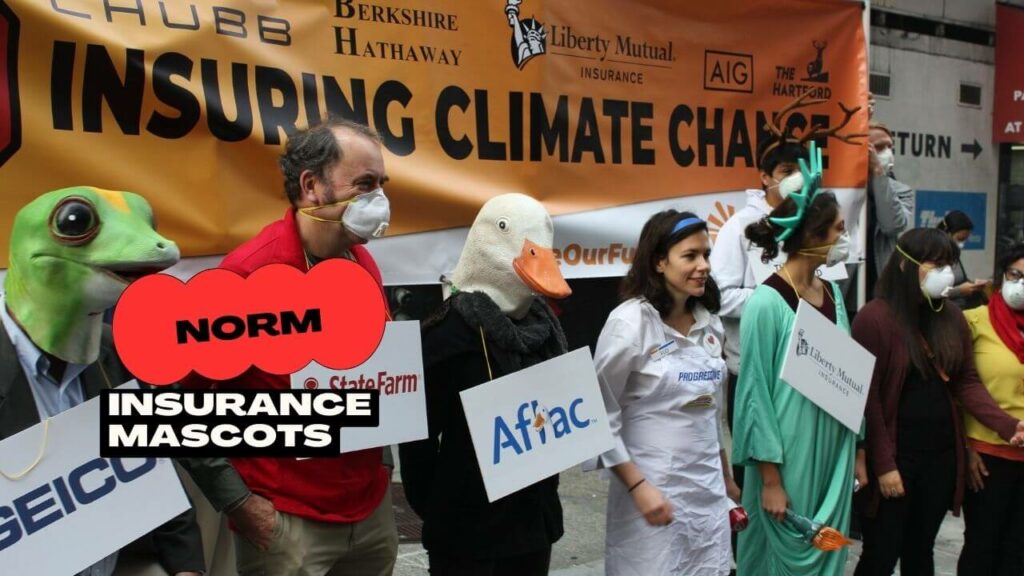Insurance mascots are fictional characters or figures that insurance companies use to communicate their services to consumers in an approachable and friendly manner and to represent their brand.
Moreover, these mascots frequently feature in marketing campaigns, social media posts, and other promotional materials to increase the insurance company’s relatability and recall value among customers

The Aflac Duck, the Progressive Flo, the Geico Gecko, and Allstate’s Mayhem are a few well-known mascots that foster a relationship with clients and contribute to humanizing the insurance sector.
What are Insurance Mascots?
These are personas that represent insurance companies, hoping to connect, enlighten, and personally connect with customers. However, they act as ambassadors to emotionally connect with customers by embodying the company’s values, personality, and messaging.
A company’s decision to forgo a mascot or jingle has become a point of differentiation for at least one insurance company, as the sector’s advertising has grown increasingly associated with anthropomorphic characters and extravagant personalities.
They can be seen in a range of marketing collateral, such as print ads, social media campaigns, commercials, and promotional items.
What is the Importance of Insurance Mascots?
For some reasons, insurance mascots are very successful marketing tools:
- Brand recognition: Raises consumer brand recall and makes insurance companies stand out in a crowded market.
- Emotional connection: Evokes feelings in customers and establishes a personal connection thereby building brand loyalty and trust.
- Simplified messaging: Simplifies difficult insurance concepts so that the average consumer can relate to and understand them better.
- Versatility: Enables the brand’s messaging to be consistent and coherent across a range of marketing campaigns and channels.
It is a valuable resource for insurance providers.
Best Insurance Mascots
The best mascots include:
- The GEICO Gecko: It should come as no surprise that GEICO’s well-known mascot, the British Cockney-accented gecko, topped the popularity and lovability charts. Since its introduction in 1999, the insurer’s mascot has grown to be the most identifiable feature of many of its advertisements. Geico demonstrated that insurance advertising can be entertaining, even absurdly silly, a notion that has since been adopted by others.
- Jake from State Farm: Everyone enjoys having a nice neighbour. Actor Kevin Miles plays the amiable Jake these days, though he’s not the original. Jake frequently uses his trademark red shirt and khakis to highlight the advantages of State Farm policies in his commercials, adding, “Like a good neighbour, State Farm is there.”
- Mayhem from Allstate: In Allstate’s Mayhem ad series, actor Dean Winters is Mayhem personified. Mayhem’s more than one-year hiatus may have hurt his popularity, but insurance buyers still like him, giving him some of the highest favorability ratings.
- Professor Burke from Farmers Insurance: Farmers is well-known for its lighthearted educational advertisements that showcase some of the most bizarre and absurd insurance claims it has ever received and offer advice on how to avoid them. Furthermore, J.K. Simmons’ portrayal of Professor Burke is the perfect character for the role.
- Flo from Progressive: Flo, the friendly and energetic sales representative for Progressive, is ranked fifth in likeability and second in popularity. Stephanie Courtney, an actress and comedian, portrays Flo in over 100 commercials for the company. These commercials often showcase hilarious scenarios involving her quirky coworkers.
- The Duck from Aflac: Aflac sounds sillily similar to the sound a duck makes. It does as this is what Aflac’s insurance mascot, the Aflac Duck has been quacking these past 20 years. Introduced in 2000, it has been a recognizable figure in many of the company’s hilarious commercials.
- Rick from Progressive: His commercials often feature amusing scenarios, such as a homeowner helping a frustrated plumber fix a pipe and another in which the homeowner has crammed so many throw pillows into the couch that there is no room left for people to sit.
- LiMu Emu and Doug from Liberty Mutual: Debuting in 2019, Liberty Mutual’s quirky emu Limu and its 70s-era throwback sidekick Doug, played by David Hoffman are relatively new to the insurance advertising scene.
- Jamie from Progressive: The fact that Jamie, Flo’s sidekick, is ranked in the top half of the list indicates how crucial the best insurance mascots are for increasing customer loyalty. Jim Cashman plays Jamie, and the two of them together have made millions, if not billions, of dollars for Progressive through their commercials.
These are the top-ranking mascots in the insurance world.
Why do Insurers Invest a lot of Money to Create the Best Insurance Mascots?
They all employ humour to convey their ideas. Additionally, they have unique qualities that set them apart and leave an impression on you.
This is the exact reason behind the creation of these enduring characters. Consequently, companies are investing large sums of money to create the greatest insurance mascots possible to boost brand recognition in a highly competitive industry like insurance.
The aim is to get consumers to prioritize their brands over all other considerations when making an insurance decision. Because insurance is an intangible good, these characteristics are essential to giving the impression that the product is more real.
Frequently Asked Questions
Below are some frequently asked questions.
Can These Mascots Change Over Time?
Yes, they are subject to change. They evolve to accommodate changes in consumer preferences, market trends, and the company’s overall brand image.
Why do Insurance Providers use Mascots?
Insurance providers use mascots to set themselves apart from competitors in a crowded market. Also, they develop a memorable and relatable image for their brand.
Do Insurance Mascots Have Any Impact on Consumer Behavior?
In general, they help to humanize the insurance industry and make it more approachable for customers. However, research indicates that insurance mascots can positively influence consumer behaviour.
Conclusion
Globally, insurance companies’ branding and marketing strategies heavily rely on their mascots.
However, these made-up people or symbols aid in giving the business a recognizable and approachable image. Thus setting it apart from rivals, and fostering a more intimate relationship with customers.
CHECK THESE OUT
